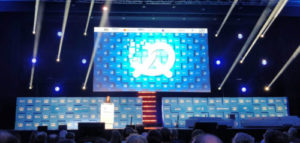The first four days of November 2022 saw the city of Lisbon filled with faces from all over the world and all corners of tech. WebSummit, the event that The Guardian dubbed “Glastonbury for geeks,” was in full swing.
WebSummit, which features more than a thousand speakers and attracts over 70,000 attendees, is one of the best places to get a sense of the conversations and issues that are being discussed—and shaping—the tech world. The grand purpose of WebSummit, as its website attests, is to answer one singular question: Where to next?
Otilia Otlacan, AAX VP of Business Operations, flew to Lisbon to, as she puts it, “take the pulse.” This autumn, WebSummit talks and panels were shedding light on a new world, one that’s buffeted by fresh issues and challenges and contemplating the ways in which tech can help build a better future.
We sat down with Otilia to get her impressions of the kinds of topics that defined 2022’s WebSummit, how the conference has changed over the last year, which talks were important and inspiring and—of course—where to get the best pastel de nata in Portugal’s capital city.
AAX: Welcome back to gray Berlin! First things first: what would you say was AAX’s overall mission at the conference this year?
Otilia Otlacan: Honestly, our purpose there was to watch and learn. We were interested in absorbing as much information about the current climate—what are people thinking about? what conversations are being had? what developments and trends are being discussed?—as we could.
While AAX is a B2B business, the backbone of everything we do is the Acceptable Ads user. We need to understand who this user is, what they want, what they engage in. And that means getting a general sense of the pertinent issues; taking the pulse.
And, of course, we were there to support the Web Summit Women in Tech Networking Evening, hosted by our friends at eyeo.
AAX: Tell us a little more—what was the Web Summit Women in Tech Networking Evening all about?
OO: It was essentially an evening of networking, sharing stories, and good food and drinks, organized by Jutta Horstmann, COO and Managing Director of eyeo and Gertrud Kolb, CTPO at eyeo. The theme was “Successes and Failures,” which served as an opportunity to discuss the ins and outs—and the many challenges—of being a woman in tech. The aim was to listen and learn and, in doing so, inspire each other to further growth.
AAX: So what were the main issues addressed at 2022’s WebSummit?
OO: I think it can be distilled into three primary topics: crypto, Web3, and sustainability.
One event that struck me as particularly interesting was the talk that Toto Wolff (team principal and CEO, Mercedes-AMG PETRONAS Formula 1) had with F1 TV commentator Rosanna Tennant and Oliver Steil, CEO of Teamviewer. When you hear the word “sustainability,” it’s very unlikely that the first thing that springs to mind is Formula 1—but that’s exactly what this panel was about.
Formula 1 wants to be carbon neutral by 2030, which is a challenge because one of the necessities of the sport is the team of mechanics, the scores of people that have to fly all over to the world to attend to the car. The number of flights that necessitates translates to a massive carbon footprint. And Wolff wants to change this—the idea is to become remote first.
To be remote first, though, it’s necessary to have the right tools. Wolff talked a lot about how using Teamviewer, including headsets, allowed remote mechanics to give help and guidance to the handful that are required on-site.
AAX: What else made an impression? Any specific talks or speakers spring to mind?
OO: Yes, absolutely. No one was more inspirational than the Ukranian first lady, Olena Zelenska, who gave the last talk on opening night. She spoke about how technology has been misused for violence but that she believes that technology can be used to save and to help people and communities. The decision to create tech that acts as a force for good, Zelenska said, can have a huge impact and “move the world in the right direction.”
Besides that speech, which was a stand-out, the majority of the talks, at least on larger stages, were discussing Web3. Crypto was a big topic of discussion. And maybe the most memorable talks that hit on these subjects came from Tim Berners-Lee, the guy who invented the World Wide Web. He said a few bold statements that have gotten a lot of attention, like “Web3 is not the web at all.”
AAX: How did the conversations at this year’s WebSummit compare to previous years? Or even just last year—how did WebSummit 2022 compare to WebSummit 2021?
OO: The focus on Web3 and crypto seemed more emphasized this year, but in 2021 people were also talking about sustainability. Sustainability is a topic that’s here to stay!
But the most prominent change, I think, was just that this year was a lot more seamless. Last year was, from a logistics perspective, hugely complicated because of Covid. The queues were up to two and a half hours long—because it was important to check not just tickets, but vaccination status and negative tests, etc. This year people were queueing, sure, but thankfully for nowhere near as long.
AAX: I’m sure the experience of being in Lisbon was phenomenal. What’s your favorite thing about Lisbon, in general?
OO: It’s impossible to pick one thing! It’s such a gorgeous place, and the weather and food are both phenomenal.
One thing I noticed about Lisbon, and about this WebSummit, was how freelancer and consultant-friendly it was. There was a huge global contingent, but I was surprised just how many people there came from Lisbon, and from around Portugal. And this really does represent a huge shift in the audience demographic—the people attending events like WebSummit used to be predominantly older, and predominantly people from large business hubs like London and Frankfurt.
That’s changed. Now you see a huge number of younger people, and they’re from everywhere. This is because you don’t need to be based in one of a few major tech hubs to do exciting work.
And I think Portugal has done a great job in attracting a vibrant demographic. Because young, talented people now have access to resources, and have the freedom to work and to exist and thrive anywhere they want. And they want to be in Portugal, eating a pastel de nata for breakfast.
AAX: Okay, last question: where’s your favorite place to get pastéis de nata?
OO: Probably Fábrica da Nata. Their pastéis de nata are so amazing, and the café is gorgeous as well.



